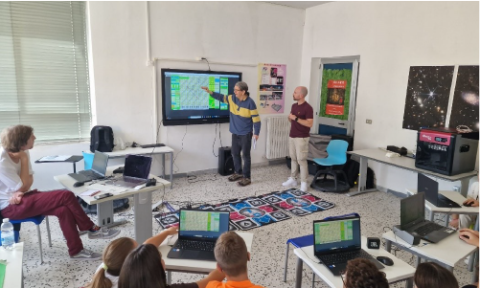Teaching Music Harmony to Schoolchildren Using Technology

By Nicholas Canny and Simon Holland
During a recent trip to I.C. Fonseca in Italy as part of the Polifonia research project, we had the opportunity to trial Harmony Space with schoolchildren between the ages of 11 and 12. Harmony Space is an interactive digital music environment that Simon Holland has been developing for many years, which aims to provide users with a way to explore a wide range of musical tasks in harmony, involving performance, composition and analysis. The software is useful for people with extensive knowledge of harmony, as well as those with little to no knowledge. At the same time, no prior experience with a musical instrument is required, unlike other approaches to learning and playing harmony. This made Harmony Space an ideal platform for children who had only recently begun formal musical training to explore harmony both visually and aurally. In the process, it enabled them to physically navigate in space with key musical concepts, such as notes, chords, chord progressions, key centers and modulations.
We devised an informative and enjoyable lesson plan, as the intent was to facilitate learning while keeping their attention throughout the workshop. To accomplish this, the lesson plan was varied and incorporated exercises that the children could constantly engage in within groups of three. To make topics clear, each exercise was preceded by short explanations describing what we were trying to achieve. This lesson plan included the following activities:
- Playing and singing different scales
- Learning how chords are constructed
- Experimenting with inversions and altered chords
- Reharmonising an existing chord sequence
- Analysing their chord sequences
- Visually finding the key center of a song
- Playing chord sequences and improvised melodies as a group
To carry out some of these tasks, we brought gaming devices, including Dance Mats and Xbox controllers, which allowed the children to experiment with harmony in an embodied manner. Furthermore, this made it easier for them to explore harmony as a group, which produced fruitful results. For example, when playing their chord sequences, one child selected the chords using the Xbox, two other children added inversions and altered chords using the Dance Mats while those who had experience with acoustic instruments played root notes or improvised a melodic line.
We were pleased with how this workshop went as we felt that we had a significant impact and learned more about the affordances and limitations of the software. Following the workshop, we received vital feedback, as each child explained what they enjoyed most and what they felt could have been improved upon. For example, most of the students appreciated the opportunity to explore novel technologies, especially since they were able to do so in small groups, which allowed them to collaborate and learn from each other. They particularly enjoyed playing chord sequences as a group using game controllers and acoustic instruments, as this enabled them to create a small orchestra.
Regarding the negative comments, some students felt the software could be more intuitive, such as a recording feature that is easier to navigate and make corrections with. Whereas others felt that more of the software’s functionality could have been explored but were cognisant of the fact that we did not explain these features as they were too advanced, especially considering the limited amount of time we had.
We hope to return soon to carry out another workshop with these children. We also intend to trial this technology with adults and people with disabilities to further investigate its potential.
Visit the Harmony Space webiste for more information.
